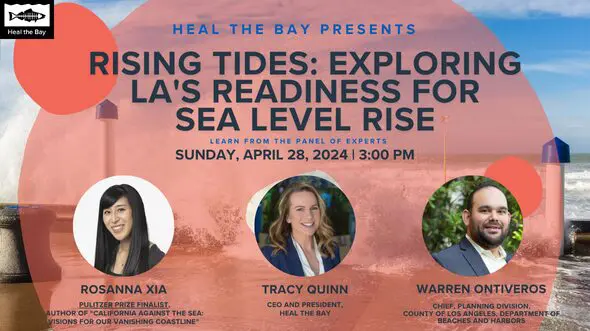FAQ: The Good, Bad & Ugly of Recent Rain
With heavy storms forecast for the weekend we take a look at what all that rain means for our local beaches and ocean:
What does the recent storm mean for our local environment?
In a time of severe drought, storms will help recharge our local aquifers and increase water supply. That’s a good thing. But all the rainfall also has a downside, namely polluted runoff hitting our local beaches and ocean.
Where does all the storm-related runoff go?
After a big rainstorm, L.A. County’s 5,000-mile stormdrain system and local waterbodies carry runoff straight to the ocean. Engineers in the 1930s and ‘40s designed the stormdrain system to prevent area flooding. L.A. is like a giant concrete bowl titled to the sea, with thousands of miles of freeways, parking lots and other impervious surfaces draining to the beach.
With such a severe drought, couldn’t we make better use of all that water dumped in the ocean?
Yes. Sending urban runoff to the sea is a huge waste of a precious resource. Los Angeles imports costly and increasingly scarce water from Northern California and the Colorado River. Storm water — if captured in groundwater basins, cisterns and other devices — could provide a safe, more secure and less costly source of drinking water. Heal the Bay is now working on a public funding measure to support regional multi-benefit stormwater capture and reuse projects.
What are the impacts of stormwater on our local beaches and ocean?
Urban runoff is the No. 1 source of pollution on our beaches. As rainfall runs through the streets and stormdrains, it picks up harmful contaminants along the way – trash, pet waste, chemicals, fertilizers and metals. All that gross stuff winds up in the ocean and along the shoreline.
In what way do local residents contribute to the runoff problem?
Among many items, Angelenos add to debris buildup by dropping nearly 1 million cigarette butts on the ground each month, according to L.A. County Department of Public Works estimates in 2010. Citizens walk a dog without picking up the droppings more than 82,000 times per month, and they hose off driveways and sidewalks into storm drains more than 415,000 times each month.
Why isn’t the runoff treated?
Some cities have combined stormwater and sewer systems, but Los Angeles has completely separate water drainage systems. The sheer volume of runoff generated in the nation’s second-largest city makes it difficult to treat.
How much runoff are we actually talking about?
After a single powerful storm, up to 10 billion gallons of contaminated water and trash flow daily through our storm drains, creeks and rivers into the Santa Monica and San Pedro Bays. That’s the equivalent of 100 Rose Bowls filled with polluted water.
What does all this runoff to do the ocean and the animals that call it home?
Countless animals each year die from ingesting trash or getting entangled in manmade debris. Seawater laden with chemicals and metals makes it harder for local marine life to thrive and reproduce.
What about the human health impacts?
Beachgoers who come in contact with polluted water face a much higher risk of contracting illnesses such as stomach flu, ear infections, upper respiratory infections and skin rashes. A UCLA epidemiology study found that swimmers are twice as likely to get sick from swimming in front of a flowing storm drain than from recreating in open water.
How can ocean lovers stay safe after rainfall?
- Wait at least 72 hours before entering the water for most beaches and avoid storm drain impacted and enclosed beaches for 5 to 10 days
- Stay away from storm drains, piers and enclosed beaches with poor circulation
- Go to Heal the Bay’s beachreportcard.org to get latest water quality grades and updates
What about the economic impacts?
People make nearly 50 million visits to Santa Monica Bay beaches each year. And the coastal economy in Los Angeles County generates more than $20 billion in goods and services each year. Polluted water and debris-laden beaches put these economic drivers at risk.
What can people do to reduce the impact of runoff-related pollution?
- Dispose of litter properly. Keeping trash out of the street, keeps trash out of the sea. Cigarette butts and Styrofoam pieces are the two most frequently found items at our beach cleanups.
- Rip up your lawn. Nearly half of our water is used to care for our lawns. Not only is it a waste of water in an arid climate, it contributes to poor water quality due to pesticides and fertilizers.
- Keep rainwater on site. Many cities offer rebates to homeowners who install rain barrels or cisterns, which capture and infiltrate rainfall for later use around the home.
What can I do to reduce the immediate impact of all the storm debris washing onto our beaches?
Consdier joining Heal the Bay’s new Storm Response Team, a rugged squad of volunteers and staff ready to give some TLC to our most trash-impacted beaches. After big storms, the crew leaps into and removes debris and catalogues it for our ongoing stormwater advocacy efforts.
Want to get a graphic, real-time look at storm debris impacting our shoreline? Check out this nighttime video of runoff hitting the beach at Bay Street in Santa Monica



